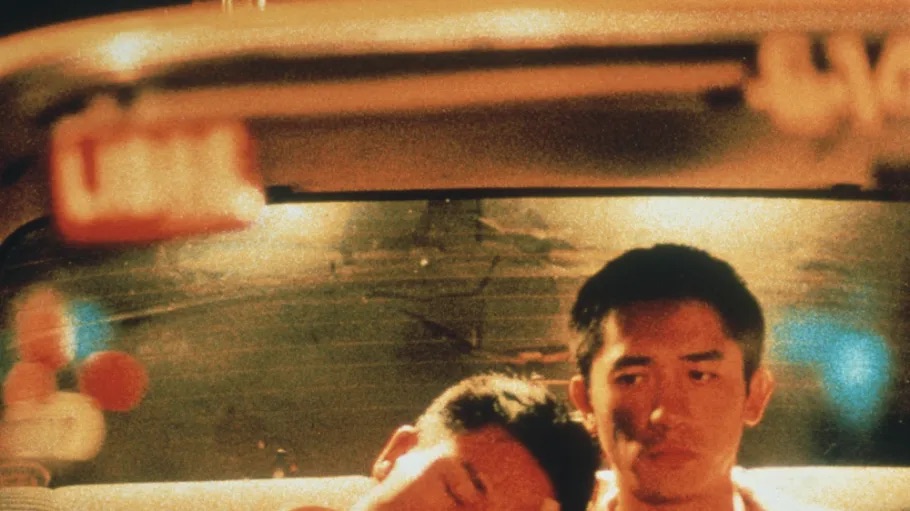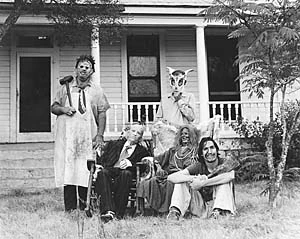by Nadia Stodder and Camden Nguyen
Tobe Hooper’s The Texas Chain Saw Massacre (1974) is regarded as one of the most iconic slasher films of all time, with its gory imagery and absurdist violence. Beginning with a stereotypical road trip taken by a group of all-American teenagers, the film takes a quick turn into horror when the friends encounter a family of cannibalistic murders, who take them out one by one until there is only one person–Sally–who manages to survive and escape. However, The Texas Chain Saw Massacre is more than just a film about senseless violence and blood-curdling screams. The film presents a perverted, somewhat Gothic portrayal of our understanding of America, subverting and critiquing the ideas of the nuclear family structure, gender roles, and how the exploitative nature of capitalism turns both the sadistic killers and those that they kill into victims in their own right.
In TCSM, even the classic tropes of a road trip film are subverted. The obstacles that the characters face along the way–the hitchhiker that they pick up, their car breaking down, the small detours that they make–are tinged with violence. Even the aspects of the road trip that are not violent in of itself have a macabre nature to them, with the first stop the characters make on the road being a graveyard, where they visit the grave of Sally and Franklin’s grandfather. Moreover, the altercation with the hitchhiker and the car breaking down are not only violent in their own right, but significant catalysts for the violence that occurs throughout the rest of the film. When the friends meet the hitchhiker he already has blood on his face, and he spends his time in their van exhibiting disturbing behaviors and obsessing over his family’s slaughterhouse, then proceeding to attack Franklin with a knife. Eventually, after the van breaks down and obligates the friends to attempt to ask for gas from the nearby Sawyer home, the violence breaks out in full force, with the hitchhiker later returning to the scene as a member of the family. While the conventions of Americana are being satirized, so too are the conventions of contemporary American stories, which in this case includes the characteristics of the standard road trip film.
Continuing the subversion of normative tropes by staining them with violence, after the car breaks down and the group are forced to look for help; they are greeted by the eerie southern gothic abode of the Sawyer family. At first glance, the Sawyer household and family appear as the perfect stereotype of American life and structure. A large farm house, lavishly decorated and inhabited by a hard working nuclear family that puts their own bread on the table; each Sawyer family member having their role as a patriarch (Grandpa), matriarch (Grandma and Leatherface at points), or the hardworking supportive children (Nubbins, Drayton, and Leatherface). Official photographs of the Sawyer family posture them in cutesy family photos, giving off the air of classic Americana such as American Gothic by Grant Wood or Turkey Feast from Norman Rockwell. But as the characters begin to explore the house one by one, they find caricatures of ornate Victorian decor using human remains, bones, skin, teeth and feathers as centerpieces. Strewn about the house are utilities for animal processing as well, a metal room with shutters, freezers, chickens in cages, meat hooks. The meticulous decoration of the place brings to mind mansions of classic Gothic horror like Dracula, only that the decor is made up of flesh and bone. The heavy decoration clashes with the solid, plain metals of hooks, shutter doors and cages; the absence of separation between a place where people live and where they are killed. They find a horror that is punctuated by violence, senselessness, and apathy; the seemingly classic nuclear family roles taken up by cruel and laughing cannibals and their house proudly displaying all of their previous victims and the butchering of attractive, normal American citizens. It is an imitation of American living by cannibal murderers, the idea that those that are evil can attempt to live in the same normative ways as all others.
In an already subverted version of the stereotypical American nuclear family, Leatherface acts as the matriarch, serving as a makeup-clad, apron-wearing homemaker who provides them food, does the cleaning, and passively takes disrespect and victimization from the other, all male members of the Sawyer family. In the film, Leatherface takes on two, seemingly opposing roles: the role of the violent, merciless killer, who wordlessly chases after innocent teenagers with a phallic weapon–a chainsaw–wearing a ghoulish mask made out of the skin of past victims while covered in the blood of his current ones. However, as the film progresses, we see Leatherface take on another, more passive role, donning a new mask, that of an old woman with bright, pigmented makeup messily decorating it. In this mask, Leatherface turns from a ruthless murderer into a member of a family, a crucial figure into making their filthy, blood-splattered house a home, in which he and his family are able to have nice, all-American family dinners, sitting around the dinner table with the corpse of Grandpa joining them and their screaming, tied up, blood-soaked guest at the head. This idea of an effeminate horror villain is not an unfamiliar one, seen in films such as Psycho, in which Norman Bates dons the skin of his dead mother as a result of his psychosexual, incestuous obsession with her, or in Silence of the Lambs, in which “Buffalo Bill” is a transgender woman whose crime is skinning young, fat women in order to turn this skin into his own as a method of transitioning. These portrayals of slasher antagonists can often become transphobic in the act of turning trans women into aggressors to be feared by cis people, who are, in a literal sense, wearing the stolen skin of cisgender women. However, in the case of Leatherface, his femininity exists less in the way of demonizing trans women and more as just another aspect of how the Sawyers exist as a wretched mirror of the average American family, differing in the way of being murderous cannibals, but not in the way of how their nuclear family is structured and functions. Though Leatherface is never implied to be anything but a cisgender man, he is treated with the same scorn and attitude that any matriarchal figure would face in a nuclear family, becoming a victim of misogyny at the hands of his family, shifting the perception of him by the audience from simply a violent killer to fear into a violent killer that you empathize with, who is a victim of his family in a different, but still notable way due to his feminine family role.
In comparison to the other queer road trip films that we watched throughout the semester, the one that most closely resembles TCSM is John Waters’ Desperate Living. In both films, the gore and disturbing character dynamics exist with the intention of shocking and repulsing audiences, appealing primarily to people who have an interest in movies that push the boundaries of what is considered acceptable or tasteful. However, TCSM and Desperate Living were not created with the sole purpose of making people clutch their pearls. In a similar way to how Desperate Living creates a warped, filthy version of an average American town, TCSM creates a warped version of an average American family, forcing audiences to reconcile with what they consider to be normal as opposed to abnormal. Much like how Peggy in Desperate Living spends the film resisting becoming like the other members of Mortville and joining their way of life, Sally in TCSM resists being–in a more literal sense–consumed by the Sawyer family and becoming another set of decorative bones after the skin has been licked clean off. However, while Peggy eventually embraces the depravity of Mortville, Sally manages to escape the Sawyer family, with the film ending on a disturbing shot of a blood-soaked Sally laughing maniacally as she rides away from the farm in the back of a truck. The horror of consumption being that of assimilation, the idea of forcibly joining an undesirable group, a theme that is common in older texts through archetypal tropes like vampirism or lycanthropy, moving into modern text through forms such as cannibalism and sex, in texts such as Hannibal or The People Under the Stairs. Moreover, Hooper and Waters both tell their story through an absurdist style, resulting in films that can both be categorized as camp. TCSM both continued and revolutionized the splatter film genre that so heavily influenced the filmography of John Waters, utilizing graphic violence as a tool to both scandalize and entertain their audiences.
At first glance, The Texas Chain Saw Massacre is a splatter horror film that has no deeper meaning besides “violence is entertaining” and “Leatherface is badass.” However, the film is not meant to merely shock people, but also to critique the American nuclear family structure and the gender roles within it, as well as reflecting the role capitalism plays in creating these structures and victimizing the people within them. The influences of TCSM can be felt in films today, from the final girl trope to the silent, masked killer meant to emulate Leatherface, but it can also be felt in the popularity of films that use a Southern Gothic backdrop in order to create horror, bringing attention to the same tragedies of American society that TCSM brought attention to in 1974. Horror movies have always bordered on the lines of camp and exploring the subversive and unattractive through the lens of killers, evoking fear through unattractive traits like violence, apathy, and sometimes queerness, looking at killers that play with queer related themes like the sensual leather bound and sadistic cenobites in Hellraiser and the performative nature of Leatherface’s masks. The genre of horror inherently comes with some level of camp through the sensationalization and focus on violence and killing as entertainment, the kind of poor taste attitude where camp plays. As a result, horror and The Texas Chain Saw Massacre are able to explore the ideas of the taboo and provide critique on normative attitudes by exploring what is deemed horrifying and this often includes exploring queer elements such as gender roles, normative family structures/relationships, and assimilation.
Bibliography
Bowen, Lexi. “‘If Looks Could Kill, He Wouldn’t Need a Chainsaw’: Gender and Leatherface in the Texas Chainsaw Massacre series,” Medium, 2022. https://medium.com/@transylvania/if-looks-could-kill-he-wouldnt-need-a-chainsaw-gender-transgenderism-and-leatherface-in-the-bef92e1aafdd.
Clover, Carol J.. “Her Body, Himself: Gender in the Slasher Film.” Representations, 1987, pp. 187-228. https://warwick.ac.uk/fac/arts/english/currentstudents/undergraduate/modules/fulllist/spec
ial/statesofdamage/syllabus202324/carol_clover_on_the_final_girl.pdf.
Rose, James. The Texas Chain Saw Massacre: Devil’s Advocates. Liverpool University Press, 2013.
Wood, Robin. “Return of the Repressed.” Film Comment, vol. 14, no. 4, 1978, pp. 25-32. https://proxy.brynmawr.edu/login?url=https://www.proquest.com/scholarly-journals/return-repressed/docview/210234247/se-2?accountid=9772.


Leave a Reply